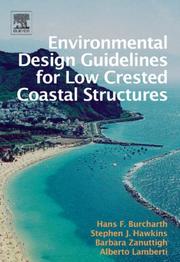| Listing 1 - 1 of 1 |
Sort by
|


ISBN: 0080449514 9780080449517 9786611096090 1281096091 0080555829 9781281096098 9780080555829 9780080555522 0080555527 Year: 2007 Publisher: Amsterdam : Elsevier,
Abstract | Keywords | Export | Availability | Bookmark
 Loading...
Loading...Choose an application
- Reference Manager
- EndNote
- RefWorks (Direct export to RefWorks)
The effect of manmade activities is primarily local but can extend far away from the location of intervention. This underlines the importance of establishing coastal zone management plans covering large stretches of coastlines. In recent years, interest in Low Crested Structures (coastal defense structures with a low-crest) has been growing together with awareness of the sensitivity to environmental impacts produced by coastal defenses. The relation between wave climate, beach erosion, beach defence means, habitat changes and beach value, which clearly exists based on EC research results, suggests the necessity of an integrated approach when designing coastal protection schemes. In accordance with this need, the present design guidelines cover structure stability and construction problems, hydro and morphodynamic effects, environmental effects (colonisation of the structure and water quality), societal and economic impacts (recreational benefits, swimming safety, beach quality). Environmental Design Guidelines for Low Crested Coastal Structures is specifically dedicated to Low Crested Structures, and provides methodological tools both for the engineering design of structures and for the prediction of performance and environmental impacts of such structures. A briefing of current best practice for local and national planning authorities, statutory agencies and other stakeholders in the coastal zone is also covered. Presented in a generic way, this book is appropriate throughout the European Union, taking into account current European Commission policy and directives for the promotion of sustainable development and integrated coastal zone management.
Coastal engineering --- Hydraulic structures --- 551.4.038 --- 551.4 --- Engineering --- Coastal zone management --- Shore protection --- 551.4.038 Coasts --- Coasts --- 551.4 Geomorphology. Study of the Earth's physical forms --- Geomorphology. Study of the Earth's physical forms --- Environmental aspects --- Design and construction --- Construction --- Automobile and Transportation --- Environmental aspects. --- Design and construction. --- Travaux maritimes --- Ouvrages hydrauliques --- Aspect environnemental --- Conception et construction
| Listing 1 - 1 of 1 |
Sort by
|

 Search
Search Feedback
Feedback About
About Help
Help News
News